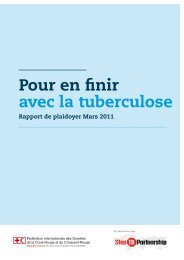Thailand - Stop TB Partnership
Thailand - Stop TB Partnership
Thailand - Stop TB Partnership
You also want an ePaper? Increase the reach of your titles
YUMPU automatically turns print PDFs into web optimized ePapers that Google loves.
arrier; reportedly, Tanzanian women often have to “choose between traveling [to a clinic]<br />
and getting their medications or buying food for the family” 36 —and often opt against accessing<br />
<strong>TB</strong> care.<br />
There are strong indications that <strong>TB</strong> is a serious health threat among migrants<br />
to <strong>Thailand</strong> from neighboring Burma, Laos, and Cambodia. Unable to read or speak Thai,<br />
lacking official documentation, and fearing deportation if they come into contact with public<br />
authorities, many are hesitant to seek treatment. Those who do seek treatment move so frequently<br />
that their treatment is often interrupted, raising serious concerns about MDR-<strong>TB</strong>.<br />
<strong>TB</strong> is having a devastating impact on other vulnerable groups as well, including<br />
prisoners, refugees, and minority groups. Yet some NTPs have failed either to conduct the<br />
necessary monitoring and data analysis themselves or to support the collaborative research<br />
with academic institutions and NGOs that would allow them to identify vulnerabilities<br />
and to develop appropriately targeted programs and services. For example, in Brazil, since<br />
Brazilians of African descent are overrepresented among the poor, it seems likely that Afro-<br />
Brazilians—and particularly Afro-Brazilian women—also suffer higher rates of <strong>TB</strong>, yet there<br />
has been little research on this issue. 37 Where such data exists, as with regard to prisoners<br />
in <strong>Thailand</strong>, the government has been able to design and implement effective outreach<br />
programs.<br />
<strong>TB</strong> and poverty<br />
There is abundant evidence that poverty increases vulnerability to <strong>TB</strong>. The malnutrition,<br />
overcrowding, poor air circulation, and unhygienic sanitation facilities commonly experienced<br />
by the poor all increase the probability of <strong>TB</strong> infection. People living in poor communities<br />
are also harder hit by the hidden costs of diagnosis and treatment and are therefore<br />
less likely to access <strong>TB</strong> services. One recent government study in Bangladesh found that<br />
70 percent of patients at DOTS centers were below the poverty line. 38 <strong>TB</strong> prevalence<br />
and mortality rates in Brazil reflect broader socioeconomic patterns, with poor and disadvantaged<br />
communities suffering most.<br />
<strong>TB</strong>, in turn, can make patients more vulnerable to poverty. <strong>TB</strong> treatment and associated<br />
costs are relatively higher for poor people. <strong>TB</strong> decreases an individual’s mental and<br />
physical capacity to work, further adding to the financial burden of treatment and multiplying<br />
the extent and impact of poverty. As 90 percent of Bangladeshi <strong>TB</strong> patients are in the<br />
most economically productive age group (15–54 years), the economic and social burden to<br />
their families is massive. According to a document prepared by the Bangladeshi government,<br />
the economic impact associated with <strong>TB</strong> and <strong>TB</strong> coping strategies is credited with<br />
pushing 30 percent of nonpoor patients below the poverty line. 39<br />
20<br />
<strong>TB</strong> POLICY IN THAILAND



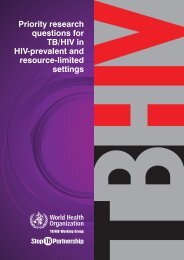
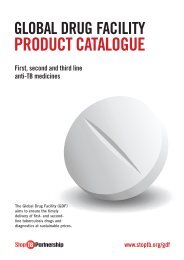
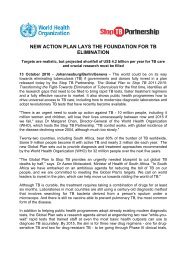
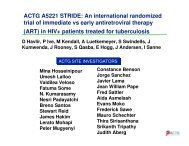
![Global Drug Facility Annual Report 2011 [.pdf] - Stop TB Partnership](https://img.yumpu.com/26788745/1/184x260/global-drug-facility-annual-report-2011-pdf-stop-tb-partnership.jpg?quality=85)

![Concept note on national stop TB partnership [.pdf]](https://img.yumpu.com/26788741/1/184x260/concept-note-on-national-stop-tb-partnership-pdf.jpg?quality=85)


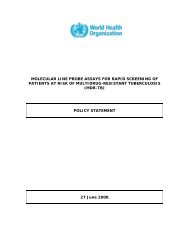
![2005 and Challenges for 2006 - 2015 [.pdf] - Stop TB Partnership](https://img.yumpu.com/26788674/1/190x245/2005-and-challenges-for-2006-2015-pdf-stop-tb-partnership.jpg?quality=85)
![Brochure (French) [.pdf] - Stop TB Partnership](https://img.yumpu.com/17234792/1/190x91/brochure-french-pdf-stop-tb-partnership.jpg?quality=85)

